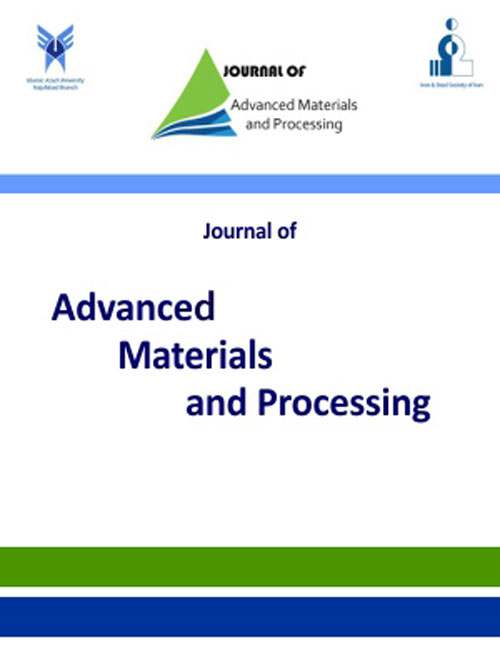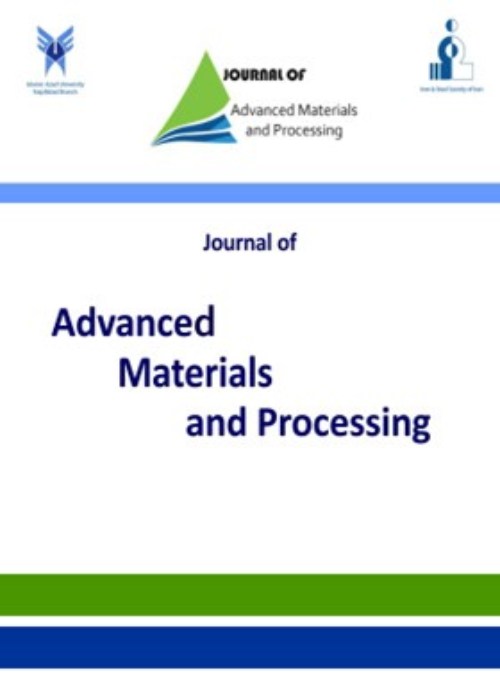فهرست مطالب

Journal of advanced materials and processing
Volume:5 Issue: 3, Summer 2017
- تاریخ انتشار: 1396/08/06
- تعداد عناوین: 9
-
-
Pages 3-11The present paper evaluates the effect of the nozzle characteristics on the heat transfer and phase change of the low carbon steel during the continuous casting process. A three-dimensional energy equation and a solidification model are used to drive the governing equation of the phase change and temperature distribution. A linear relation is obtained to predict the temperature-dependent of the solid volume fraction in the mentioned steel. An effective thermal conductivity is used to simulate the advection effects of the liquid steel. The effective heat capacity is assumed to model the phase change in the mushy zone. The predicted values of the model are compared with the experimental ones. The regression values confirm a good agreement between the modeled and experimental values. The effects of geometry of the slab and the secondary cooling characteristics are examined on the heat transfer and solidification of the steel slab. The slab thickness has a significant on the solidification and by increasing this parameter, the metallurgical length will increase.Keywords: Continuous casting, Heat transfer, Phase change, Effective thermal conductivity, Secondary cooling
-
Pages 12-22Nowadays modification of metallic biomaterials which are used as implants for bone and hard tissues replacement is considered as an important subject. In the current study, corrosion fatigue properties of Ti-6Al-4V alloy investigated via Rotating-Bending standard test method and then, the results compared with the fatigue properties of the specimens tested in the same conditions. Scanning electron microscopy used to investigate the chemical composition (EDS- Energy-dispersive X-ray spectroscopy), microstructural features and crack propagation characteristics. Results showed that the presence of corrosive environment not only results in decrease in fatigue life, but also eliminates the fatigue limit. Further studies revealed that aggregation of corrosion products, with more hardness values, at the crack tip cause an obvious deviation of crack propagation from its main direction. Therefore, a tortuous crack path through the bulk of the specimens was detected concurrent with penetration of solution into the crack. In addition, dimensions and morphology of fatigue crack surfaces were completely different from corrosion fatigue cracks as well.Keywords: Ti-6Al-4V alloy, Corrosion fatigue, microstructure, Fracture surface, Striation features
-
Pages 23-32Co3W2Si intermetallic compound was synthesized by mechanical alloying (MA) of W, Co and Si elemental powder mixtures. The phase composition of the milled products was evaluated by X-ray diffraction (XRD) analysis. Morphological evolutions were characterized by transmission electron microscopy (TEM). The results showed that high energy ball milling performed in the present work led to the formation of Co3W2Si intermetallic phase after 50h MA. A thermodynamic analysis of the process was then carried out using Miedema model. The thermodynamic results showed that there exists a positive thermodynamic driving force in WSi and Co-Si binary systems and W-Co-Si ternary system to form a solid solution at all compositions but Gibbs free energy change in Co-W binary system is positive for solid solution formation. So that, there is no thermodynamic force to form a solid solution in Co-W system. In Co-W-Si ternary system, the addition of elemental W to Co3Si compound decreases Gibbs free energy change and more stable structure forms.Keywords: Mechanical alloying, Co3W2Si intermetallic compound, Thermodynamics
-
Pages 33-44Structural health monitoring (SHM) systems operate online and test different materials using ultrasonic guided waves and piezoelectric smart materials. These systems are permanently installed on the structures and display information on the monitor screen. The user informs the engineers of the existing damage after observing signal loss which appears after damage is caused. In this paper health monitoring is done for plate shaped structures made of ST-37 steel. After conducting the experimental tests, the stored signals by the multi-layer artificial neural network algorithm is processed and the damage caused in the plate is detected. By analyzing the graphs, it becomes clear that after causing damage the signal amplitude decreases. In the experimental test two piezoelectric discs are used on a steel plate which have been installed using a strong adhesive. Using a strong adhesive improves wave, propagation in the structure. Developing innovative testing methods for the SHM system has caused better control in structures after assembly.Keywords: structural health monitoring, ST-37 plate, piezoelectric, smart material, artificial neural network
-
Pages 45-52Pyroplastic deformation is a distortion of the ceramic shape during the sintering process. It occurs because the flow of the vitreous phase at high temperature and the applied stress due to the weight of the product during sintering process. The aim of this paper deals with describing a numerical-experimental method to evaluate the pyroplastic deformation, to predict the anisotropic shrinkage and heterogeneous densification for ceramic materials during the liquid phase sintering process, as a function of sintering time. For this purpose, three experimental configurations including midpoint deflection, sinter bending and free sintering test were designed; the finite element method are implemented by the CREEP user subroutine code in ABAQUS. The fair accordance between simulation results and experimental data reveals that the shear and bulk viscosity modulus as well as dynamic viscosity used in the simulation are near the real ones. The anisotropic shrinkage factor K_xy has been proposed to investigate the shrinkage anisotropy. It has been shown that the shrinkage along the normal axis of slip casting is about 1.5 times larger than that of casting direction. The inhomogeneity in Von-Misses, pressure, and principal stress intensifies the density non-uniformity in the samples.Keywords: Pyroplastic deformation, Finite element simulation, Heterogeneous densification, Sintering, Anisotropy shrinkage
-
Pages 53-65Amorphous silica thin films were applied on the 316L stainless steel substrates by sol-gel dipping technique. The starting chemicals (TEOS, ethanol, HCl, PEG, and NaOH) were used to prepare a gel and then deposited on a substrate. The microstructure, topography, corrosion behavior, and surface hardness were investigated using SEM, AFM, electrochemical method, and micro-hardness measurements. The fabrication parameters utilized to enhance the anticorrosion and mechanical properties including calcinations temperature, pH value, and mole ratio of alkoxide to alcohol were studied. Taguchi approach was used as a statistical experimental design technique to set the optimal parameters. Roughness and current corrosion density were evaluated as the response parameter.
pH is the parameter of most major effect on the roughness; pH less than or equal to 4 increases the roughness but more pH value decreases the roughness. The ratio of alkoxide to alcohol is the most influential variable on current corrosion density. The increase of alkoxide amount improves the corrosion behavior, which might be related to the increase of the coating density. Consequently, the optimized conditions obtained through Taguchi method target at reaching the highest anticorrosion efficiency involving calcination at 300 °C, pH=6, and the mole ratio of alkoxide to alcohol as 0.167.Keywords: Amorphous silica, Sol-gel dipping technique, Taguchi approach, anticorrosion coating -
Pages 66-72It is well-known that the harsh operational conditions of turbine blades lead to a gradual change in the microstructure of underlying Ni-based superalloy of blades. According to this, a rejuvenation process should be conducted on turbine blades superalloys to recover their microstructures. The first and main step of rejuvenation process is the determination of appropriate solution condition in which ϒʹ precipitates dissolve in the ϒ matrix. In this study, different heat treatment conditions were applied on a Ni-based single crystal superalloy to determine its solution condition. The results of scanning electron microscopy (SEM) studies showed that with increasing the solution treatment temperature from 1275°C (3h) to 1330°C (3h), first, ϒʹ precipitates at dendritic regions dissolve and only after increasing the solution temperature to 1350°C (3h), complete solution of ϒʹ phase occurs. The full solution condition (1350°C-3h) will be used as the first step of the rejuvenation process of these blades in future studies.Keywords: Nickel- based superalloy, Rejuvenation heat treatment, Gamma prime precipitates, microstructure
-
Pages 73-81Combination of sol-gel and hydrothermal routes in the metal alkoxide binary system of Al(OR)3-Ti(OR)4 (R= -CH(CH3)2 or -CH2CH2OCH3) were investigated to prepare single phase aluminum titanate (tialite). The effects of various parameters, such as hydrothermal processing temperature, solvent polarity and the type of alkoxide precursor, in phase development of the product powders have been investigated. Phase development of the product powders was followed by means of infrared spectroscopy (IR), X-ray powder diffraction (XRD) and thermal analysis (TG/DSC). Results of XRD patterns showed that when the polarity of solvent increased by using a mixture of toluene and isopropanol instead of pure toluene solvent, phase development of the product powder retarded and needed higher temperature (more than 1400ºC) to produce single phase tialite. Similar effect was observed when aluminum 2-methoxyethoxide and titanium 2-methoxyethoxide used instead of the aluminum iso-propoxide and titanium iso-propoxide. These observations were attributed to the more controlled hydrolysis conditions in the hydrothermal assisted sol-gel process.Keywords: hydrothermal, Aluminum titanate, Aluminum alkoxide, Titanium alkoxide, Al2TiO5
-
Pages 82-92In this study, nanometer sized of Ag/Fe3O4 nanocomposite (AFN) have been synthesized by using a simple and based on chemical reduction method. The size and shape of (AFN) controlled by using of condensation (Fe2O3 (2.975 mmol), NaBH4 (21.25 mmol), AgNO3 (2.532 mmol) and polyvinylpyrrolidone (PVP) (8.925 mmol K30 Mr=10.000) in 40 ºC. The synthesized AFN was characterized by XRD, scanning electron microscopy (SEM), transmission electron microscopy (TEM) and electron diffraction X-ray (EDX) spectral techniques. Measurements of X-ray diffraction (XRD) confirm that Ag/Fe3O4 nanocomposite have the crystalline structure. The scanning electron microscopy (SEM) images of the as-deposited Ag/Fe3O4 nanocomposite (AFN) have been shown that the particles aggregate into an organized spherical structure, which is characterized by diameter of 10-20 nm. This type of porous aggregate is characterized by large surface area, which could have potential applications in the areas of catalysis and filtration. The population distribution as measured from the TEM images shows the average particle size for the AFN nanocomposite is 10-20 nm.Keywords: Ag, Fe3O4 nanocomposite, Catalyst, Laser vaporization, Scanning electron microscopy (SEM), X-ray diffraction (XRD)


